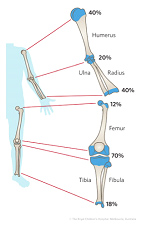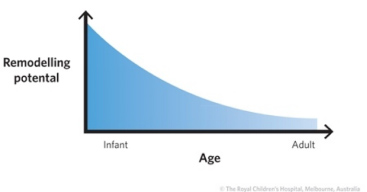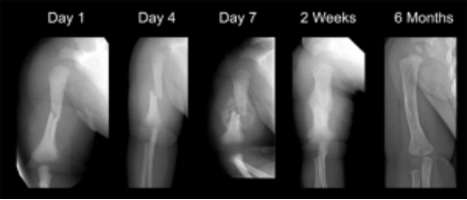Fractures/Broken bones in children are very common. Children who are still growing have different anatomy, they are not ‘mini adults’ and therefore their fractures need special consideration and treatment.
Children have growth plates in their bones, where new growth is formed. If these are injured it can have long lasting consequences on their growth and soft tissue development if not treated appropriately. Children’s bones also are softer and more elastic than adults, this makes it much easier to bend rather than break/fracture. Similarly, children’s bones are covered in a very thick layer of supporting tissue called periosteum, which assists in fracture healing, and means that they recover much faster than adults’. Children also have great potential to ‘remodel’ or ‘grow out’ deformity from fractures, which adults cannot do.
Growth plates of the body and how much they contribute to limb length
 If your child has a growth plate fracture they may show symptoms such as:
If your child has a growth plate fracture they may show symptoms such as:
Dr Maor may diagnose growth plate fractures with the help of imaging tests such as X-ray, CT scan and MRI.
Treatment for growth plate fractures depends on the severity of the fracture.
The majority of children’s fractures can be treated without open surgery. Non-surgical treatment commonly involves:
Due to the remodelling potential of children, even if the bones are not perfectly aligned, over time as the child grows they will straighten out, this is known as “remodelling”. This process can take years to be complete. The key considerations for Dr Maor to decide whether or not a fracture will remodel sufficiently are:
 The rate of remodelling in a child is inversely related to age. In younger children, remodelling is rapid and often complete. It is slower in older children and much slower in adolescents.
The rate of remodelling in a child is inversely related to age. In younger children, remodelling is rapid and often complete. It is slower in older children and much slower in adolescents.
Fracture and bone remodelling potential with age

Right Femur fracture showing remodelling (straightening) over time)

Humerus (arm bone) showing remodelling over time
Surgical treatment is sometimes required for children’s fractures to assist in realigning bones and joints to allow effective healing to occur. This may involve:



